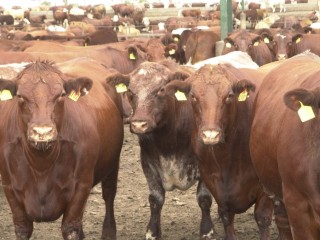 The only saving grace in the latest feedlot profitability calculation carried out by Beef Central yesterday is that the result is not as bad as it was in the previous exercise, compiled back on June 15.
The only saving grace in the latest feedlot profitability calculation carried out by Beef Central yesterday is that the result is not as bad as it was in the previous exercise, compiled back on June 15.
The sums on feeding 100-day grainfed cattle have eased back towards the positive side of the ledger a little this week, on the back of reduced feed prices and cheaper feeder cattle.
An analysis based on yesterday’s spot market for inputs suggested a breakeven figure of 365c/kg dressed weight for 100-day grainfed steers ex-Darling Downs, going on feed today and closing-out during week-four in October.
That’s down 10c/kg on a similar analysis done four weeks ago. The main reasons are that finished ration price has eased $10/t to $255/t due to easing in the feedgrain market, while feeder steer prices have dropped around 5c/kg liveweight over the past three weeks to 175c/kg.
Total cost calculated was $1278 (down about 3pc from $1316 on June 15), including feeder steer purchase plus typical feeding program, and a 1pc mortality rate.
The big influence in cost/price variables overall continues to be in the over-the-hooks forward market price for late October, which, while difficult to define due to lack of processor participation, sits in the 350s, down from the high 370s seen in early June's calculation.
The spot market for 100-day grainfeds today is around the 325c/kg mark, down from mid 350s four weeks ago. That’s due mostly to the backlog of meat in the supply chain, plant closures and very flat demand in Japan.
All this means today’s proposition for close-out in 100 days’ time is about 15c/kg dressed weight below breakeven, worth about negative $45 a head. That’s not as bad as the extreme negative $89 figure reported three weeks ago, but still a long way from profit.
The calculation is based on assumptions including a 356kg dressed weight, average daily gain of 2kg, and a feed conversion ratio of 7.5:1 (as fed).
Similar calculations made pre-Easter produced a 100-day profit result very close to breakeven.
Forward-contracted 100-day product closing-out today (going on feed in April as feeders worth 205c) carried a breakeven of about 400c/kg, which represents a breathtaking $285 per head loss to processors in today’s market, based on a current spot price of 325c. That figure, alone, demonstrates the extreme pain export processors handling grainfed product are currently experiencing.
Feedlot survey
Breakeven figures like those produced this week do not auger well for the quarterly feedlot activity survey for the period ending June 30, to be published later this month. Compared with the solid outlook just three months ago, there is a lot more bearish sentiment evident around in Australian lotfeeding circles at the moment, and no immediate signs of change in market variables.
One saving grace could be that the timing of the survey may miss catching the worst of the recent profit declines and slowdown in placements. If the survey was to be conducted at the end of July, instead of the end of June, the state of the grainfed industry could have looked a lot worse, a reliable lotfeeding contact told Beef Central.
Reduced kills by processors to lower the amount of overall beef in the market, narrowing the gap between beef supply and demand, is seen as part of the short-term solution by some stakeholders.
One lotfeeder felt it unlikely that feeder steer prices would decline much further. If they did, many breeders would elect to retain cattle on the abundant feed at their disposal and grow the cattle out to grassfed export weights themselves over the next six months.
Other prospects could be an easing in the value of A$ through to the end of the year, which some finance sector analysts are forecasting. A currency at around parity with the US$ would add competitiveness to Australia’s exports in important customer countries.
Another factor could be potential beef shortage in the US in coming months due to widespread drought (see separate story "US cow kill ramps-up as drought bites") which could help elevate prices for Australian exports. Typically, Australian grainfed heavy steer prices hit a peak around November-December, but whether 2011 follows that pattern remains to be seen.
“With processors taking $200 hits on shortfed Jap ox they are processing today, it is probably a little difficult for them to see optimism in four months’ time,” one large lotfeeder said.
“While the market appears to be turning, the average export processor’s weekly profit-and-loss would still be looking pretty ugly, meaning the enthusiasm to put some cherries out in front is going to be hard to find – despite the historic price strength at the end of the year.”
Yesterday’s NLRS Eastern Young Cattle Indicator closed at 375.5c, down 0.5c on a week ago. The NLRS feeder steer indicator was up5c for the week to 200.6c.
-
• Beef Central publishes a fortnightly 100-day grainfed breakeven scenario based on a standard set of production variables (ex Darling Downs). While a representative set of variables has been chosen, it is important to note that variations can exist across production models (FC, daily gain, mortality, morbidity, carcase specification), from feedlot to feedlot, and between mobs of cattle. For a more specific performance forecast on a given mob of cattle, contact your preferred custom feeder.
